Cape Verde Fauna (Beasts and Birds)
Discounting domestic animals, there are only 13 species of mammal resident in the Cape Verde islands. Three of them are bats, one is a mongoose, and the others are all dolphins and whales – which is cheating, if you ask me.
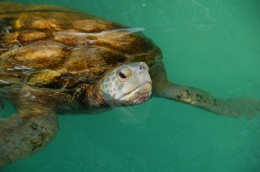
There are also 19 or 20 reptiles living here – but don’t panic, because none of them are snakes. In fact, five of them are turtles, which come here to breed, and the others are all lizards, skinks, and geckos.
Going, Going… Gone?
All but two of the lizards and their kin are endemics, living nowhere else on the planet, and some are threatened with extinction. Indeed, one may already be extinct. Known as the Cape Verde Giant Skink it lives – or lived – only on the islet of Raso. As the story goes, convicts marooned on this desolate lump of rock ate every lizard that they could find, with the result that none has been seen in almost a hundred years.
Mind you, since nobody ever goes to Raso this is not very surprising…
There are numerous species of endemic creepy crawly – but we won’t go into them here; so that just leaves the birds.
For the Ornithologists
187 species of bird have been seen in the islands, but of these 75 are rare migrants which have been glimpsed only once or twice; so that brings the tally back down to just over 100. Given a couple of months and a boat to get from island to island, one could probably see all but one of them without too much trouble; but that last one is never going to feature on the lists of any but the most obsessive of twitchers.
Just four birds are endemic to the Cape Verdes and can be found nowhere else in the world.
The Cape Verde petrel, or gon-gon is, indeed, very nearly gone. It nests only in the high mountains and is considered to be an endangered species.
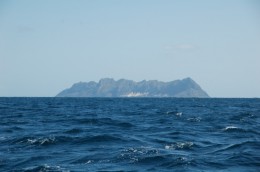
The Cape Verde shearwater, or cagara, nests on the uninhabited islets of Branco and Raso and also in Brava. An endangered but non-endemic species, its plumage is very similar to the Cory’s shearwater which can also be found hereabouts. The two can be recognised by their different jizz and different beak colour. (The cory has a yellow beak.)
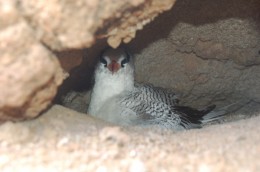
Seafarers may also see storm petrels (known as jabe-jabe), brown boobies (alcatraz), frigate birds (rabil), and red-billed tropic birds (rabo de junco). The latter two species are very rare in this vicinity – but we have seen them both.
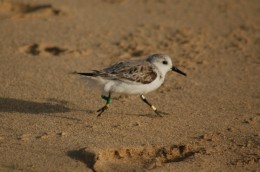
Heading ashore one can also find various waders, including sanderlings (sanderlingo) – which run up and down on the sandy beach at Santa Maria, in Sal – spoonbills, which I have seen on the beach in Mindelo, of all places – and stilts, which hang out at the salt pans in Pedra do Lume, Sal.
Kestrels (filili) are two a penny everywhere you go in the countryside. Egyptian vultures (canhota) are not, but we have seen them in Santiago and on the southern end of Santo Antao.

Wandering in the mountains you may see quail (codorniz) and guinea fowl (galinha guinea), and down on the desert flats you should look out for hoopoe larks (cotovia), with their lovely black and white wings.
Unless you go to the uninhabited islet of Raso you will not see the endemic and critically endangered Raso’s lark (calhandra do Raso). Hopefully it will not distress anybody too much to think of it living its life in perfect peace, without being visited…
Kites (milhafre) are said to be common, but I have never ever seen one anywhere in the archipelago.
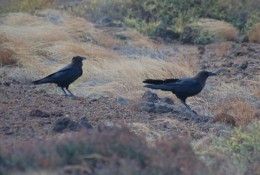
There are certainly quite a lot of brown-necked ravens (corvos), especially in Sal and Sao Nicolau.
If you visit Brava then you will probably see the endemic kingfisher (passarinha) – a very noisy bird with striking plumage. There being no rivers or quiet fish-filled lakes and lagoons in the Cape Verdes the vagrant ancestors of this bird survived by eating insects, and the species now lives exclusively on a diet of grasshoppers, locusts, and so forth.
The kingfisher can also be found in the greener parts of Santiago; and if you wander about in the right place in the mountainous parts of that same island, then you might be lucky enough to see one of the last remaining Cape Verde peregrines, or soutadors.
Another species to watch for in Santiago is the Cape Verde cane warbler, or tchota de cana (the fourth, and last endemic). This little bird used to be found in Brava and Sao Nicolau as well but is believed now to be extinct in those islands.
If you think you’ve glimpsed a curlew flying by it was probably a whimbrel; and if you hear strange mewing noises don’t assume that there is a seagull hanging about. There are very few seagulls in the Cape Verdes, but there seem to be quite a number of ospreys (guincho, in the local lingo) and they make a variety of rather lovely noises, including seagull impersonations.
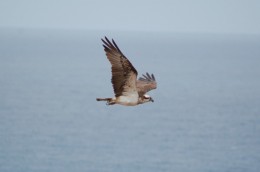
We have seen pairs of ospreys and found their nests in several Cape Verdean islands. They appear to be relatively unafraid of man and his machinations, and they are often to be seen flying low around the anchorage in Mindelo (São Vicente) or skimming over the ferries berthed nearby. Meanwhile, in Boa Vista we have even had them land on our mizzen mast.
Watch these birds for long enough and you will often see one catching a sizeable fish with his talons and carrying it away towards the mountains.
One sincerely hopes that the sudden expansion of the towns and the urban development of the once-bare hillsides will not drive these magnificent birds away from the islands… but already we know of three nesting sites which have been abandoned.
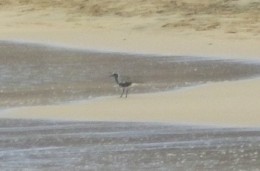
As I said at the outset, numerous vagrants have been sighted in the islands and whilst poring, in a half-hearted manner, over some photographs taken by a non-birding friend I was startled to see what appears to be a golden plover wandering around in one of his “deserted beach” scenes.
If you are sufficiently knowledgeable to be able to tell the difference between one LBJ and another then it is certainly worth keeping your eyes open, and if you can get some decent snapshots of any suspicious characters there are organisations which would probably be pleased to add your sighting to their records.
For more information about the Cape Verde islands, take a look at our other recent articles about the archipelago:
- General info:
- Sal
- São Vicente
- Boa Vista

Dear Jill and family,
happy to read the first newletter you mailed – I am new on you list. Sure I’ll follow you as well on facebook, but
it is nice to have also a more “private” contact. It is wonderful to learn about your life – and there is something
like envy…. Dreamlife, even if I can imagine that you are also having hard times, but anyway, thank you for
your articles, beautiful photos…
With a lot of sympathy, Bea
OK got the fauna but where’s the flora or is there none? We have booked to go there in February we are in our 70’s just like the quiet life and like to see life as it is, We don’t sail, surf etc but just like to wander and see life in other countries. Think we will like this unless there is boom boom music everywhere.
Sorry for the delay, Carol and John. This is the link to the Flora article – https://www.yachtmollymawk.com/2011/11/cape-verde-flora/
Cabo Verde of one of my favourite places; perhaps my absolute favourite. I hope you enjoy it too.